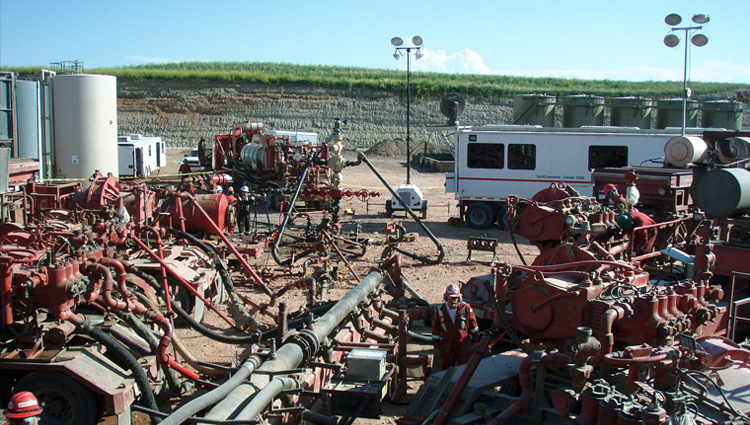University Study: Fracking's Effects on Groundwater May Be Overblown
(ISNS) -- A University of Texas study has found no evidence that fracking -- hydraulic fracturing of shale to extract natural gas -- is contaminating groundwater.
Problems associated with the process have been reported in water, but they appear to occur at ground level or just below the surface, according to the study released Friday. Many are common to any natural-gas extraction process, or are the result of mishandling of wastewater, the researchers said.
"The bottom line was, in the areas we investigated ... we found no direct evidence that hydraulic fracturing itself was contaminating groundwater," said Charles Groat, professor of geology at the University of Texas at Austin.
Hydraulic fracturing, or fracking, involves injecting water, sand and chemicals at high pressure into shale, which shatters the rock, releasing natural gas. Wells are dug straight down into the ground and then branched off horizontally into the shale, making the gas far more accessible.
Natural gas is the cleanest-burning hydrocarbon fuel, and North America has vast reserves that could replace petroleum products from overseas. The development of techniques that allow horizontal drilling has made it economical to extract the gas from shale seams.
It is not clear how the study will play in areas in which the fracturing process is considered a public-health problem because of contaminated water. There even have been documented cases in Ohio and Pennsylvania homes of dissolved methane in the water either catching fire or exploding.
Fracking is specifically exempt from the Clean Water Act.
The study was performed by the University of Texas' Energy Institute and was completely funded by the university "so it was not dependent on sources either from the energy community or the environmental community," Groat said. The Environmental Defense Fund "also assisted in developing the scope of work and methodology for the study," according to a university press release.
The $308,000 project studied three areas: the Barnett Shale in North Texas; the Marcellus Shale in New York and Appalachia, and the Haynesville Shale in western Louisiana and northeast Texas.
An earlier study by Duke University at the Marcellus site found a buildup of methane in water near fracking drills. Methane is the main constituent of natural gas.
The water in the Marcellus area has considerable amounts of dissolved gas naturally, Groat said. It was there before the drilling.
"People were able to set water on fire, so something was happening," Groat said at a press conference on Thursday at the meeting of the American Association for the Advancement of Science in Vancouver, British Columbia, where the report was released. "We’re not denying these things happen and we need to know why."
The report said that most of the issues identified were at the surface or just below the surface, and some of them may have been caused by breaks in the concrete lining the wells, which is common to oil and gas drilling operations.
There also have been reports of small earthquakes in drilling areas in North America and Europe. That may be the the result of drillers pumping the wastewater back into the ground, which expands the reservoir, Groat said.
"We have not seen whether the fracturing itself is causing the microseismic activity," Groat said. "More work needs to be done."
Regulations in the states usually were written before the technology became widespread but generally work well, Groat said. Some of the controversy is what he called "landscape," largely cultural dissonance in areas not used to oil and gas production, with its drills, large pipes and huge trucks on the streets.
Danny Reible, an engineering professor at the Texas institute who was not part of the study, said he independently came to the same conclusion. His work was in finding areas of research where research was most needed, and concluded that contamination was occurring at the surface or just below the surface, as the report found.
"We are hobbled by a lack of baseline information," Reible said. "There is potential for concern."
Reible said the problem with wastewater may be that there are so few wells to reinject the water.
"Shale gas has lots of stories to tell," Groat said. "It’s a great resource for this country and many other parts of the world. It's a game-changer in terms of the energy balance. We think it can be regulated effectively and is being done so largely, but certainly there are evolving issues that need more serious attention paid to them."
"The study shines a light on the fact that there are a number of aspects of natural gas development that can pose significant environmental risk," wrote Scott Anderson of the Environmental Defense Agency on his blog. "And it highlights the fact that there are a number of ways in which current regulatory oversight is inadequate."
It was not, he wrote, the final word.


